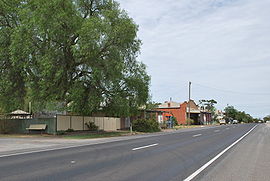Walpeup, Victoria
|
Walpeup Victoria |
|||||||||||||
|---|---|---|---|---|---|---|---|---|---|---|---|---|---|

The Mallee Highway at Walpeup
|
|||||||||||||
| Coordinates | 35°08′10″S 142°01′30″E / 35.13611°S 142.02500°ECoordinates: 35°08′10″S 142°01′30″E / 35.13611°S 142.02500°E | ||||||||||||
| Population | 108 (2006 census) | ||||||||||||
| Postcode(s) | 3507 | ||||||||||||
| Elevation | 69 m (226 ft) | ||||||||||||
| Location | |||||||||||||
| LGA(s) | Rural City of Mildura | ||||||||||||
| State electorate(s) | Mildura | ||||||||||||
| Federal Division(s) | Mallee | ||||||||||||
|
|||||||||||||
Walpeup /wɔːlpiːˈʌp/ is a town in the Mallee region of north west Victoria. The town is in the Rural City of Mildura local government area and on the Mallee Highway and Pinnaroo railway line between Ouyen and the South Australian border, 458 kilometres (285 mi) north west of the state capital, Melbourne and 130 kilometres (81 mi) south west of the regional centre of Mildura. At the 2006 census, Walpeup had a population of 108.
The township was settled when the railway arrived, a full post office opening on 16 December 1912. The area of the locality contains the smaller area of Paigne which had a post office open from 1912 until 1916.
The Mallee Research Station at Walpeup was established in 1922 to research dryland farming in the Mallee. It is a campus of the Sunraysia Institute of TAFE. It also has a Bureau of Meteorology automatic weather station.
Walpeup Primary School opened on 3 June 1912 in the "Little White Hall", with a one-room school building being built in 1914. A second room was added in 1927. The school was "de-staffed" from April 2015, with the last five students having to transferring to Underbool school.
Walpeup South State School (No. 3929), alternatively known as Hungry Hut, opened in 1912 and closed in 1951. The building was later moved and served as the dressing shed at the Walpeup Recreation Reserve.
The main tourist attractions in Walpeup are the Walpeup Memorial Hall (Glen Street) and the Dryland Gardens (Creagan Street). The Hall houses a large collection of historic photographs of locals who served in either World War, a "welcome home" banner from the First World War — only found within the last five years and now restored and displayed — and a hand-sewn community mural tapestry created in 1989. The Dryland Gardens, on the corner of Glen and Creagan streets, display many native trees and shrubs from around the local region and Australia, particularly a large variety of Eremophilas. The garden is tended by local volunteers.
...
Wikipedia

